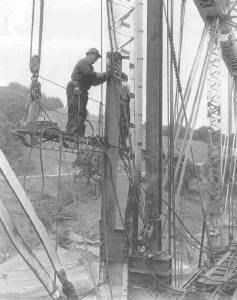The rain pouring down outside melting several inches of snow reminds me of the floods we used to have here in Humboldt in the Sixties and Seventies. And the logs that floated down those raging waters. They were huge and there were lots of them.
Two of our best sources for local history, Ernie and Ecovox have been commenting (1/28-1/29) on how newcomers wrongly blame the forest and mining industries for the disastrous big floods. I don’t have enough scientific background to know who is correct but I do know that 30-50 years ago, in the winter, logs came down in massive amounts. Some people even supplemented their income by harvesting these floaters. My dad told me that he can remember seeing people out in a little 18-20 foot boat hooking the logs. The money from the lumber was so lucrative it was worth risking your life over. In fact, even though there are less logs today, people still are willing to do a little log pirating.

We lived down at Smith Point at the old Smith Ranch(just off 101 north, of where Bigfoot Burl is located) in the late sixties and very early seventies. One year, I remember the logs jammed down by the bridge just North of our house and the water backed up dangerously. I can remember my dad going out and pushing a stick into the ground at the edge of the water. Then he went out every half hour or so to see how far the flood had risen. Eventually the log jam broke and the water finally went down instead of up. I don’t remember seeing any log jams in recent times, though.
In spite of the hazard the logs created, sometimes people couldn’t resist testing the waters. Riding the logs, like the story in the newspaper clipping at the top, wasn’t the only crazy way people rode the flooding river. My dad tells of working on the roads between Dean Creek and Sylvandale and seeing “some nut going down the river” on a surf board. The “nut” was Dr. Pierson, a respected member of the local hospital. Today, though, a log is a rare occurrence. In 2006, when The North Coast Journal described the flooding at Ferndale that year, the reporter noted people remembering “it wasn’t like the old days ‘when huge logs would fill the river.’”
When we went to the ocean as a kid there would be huge piles of driftwood logs. As I grew older, I would realize most people thought of driftwood as charming arm length pieces of art—lovely for decorative fencing at summer cottages—but the driftwood this close to logged areas was huge. Massive skeletal armies of silvery gray trees, some still attached to roots like muscular tentacles, were thrown against the eroding cliffs by the rage of winter storms. Some were the direct result of the timber companies’ inroads against the forest—their trunks, amputated from their soil encrusted life sources ended in flat wounds from which sap sometimes still seeped. Others were indirect casualties—their roots had been torn from their home-ground by massive slides (which some people feel were caused by over logging) followed by the heavy rains characteristic of Humboldt and Mendocino Counties in the winter. Others were the undead sucked from their forest graves where they had been rotting peacefully and spat into the swirling muddy waters common in ravaged forest lands. The ocean took the long dead and newly dead and peeled any flesh or weak areas away and then flung the hardened remnants back onto the beaches of my childhood.
Today, a log or two a winter are all I see. I don’t know but I don’t think logging caused the big floods alone but I think logging practices added to the problem. There were too many trees floating down the river then as compared to now. There were more downed trees to float but there were also more slides that threw whole trees into the river. At least that’s what I think when I compare the floods now with those of my childhood.

CLICK TO MANAGE